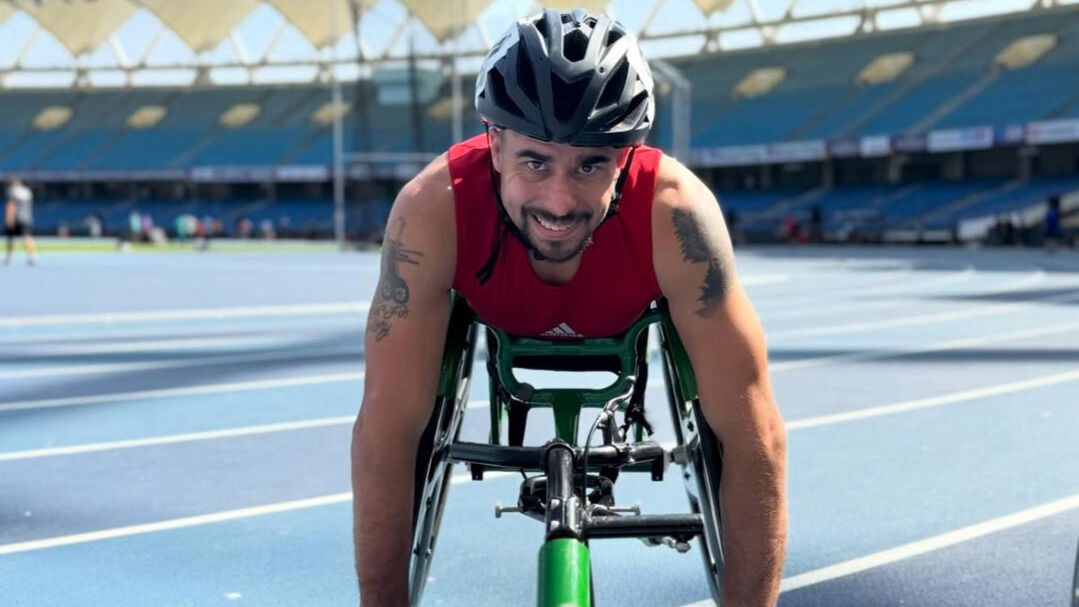
Imago
Bob Hunt at the 2025 World Paralympic Championships, New Delhi. Pic Credit: Instagram

Imago
Bob Hunt at the 2025 World Paralympic Championships, New Delhi. Pic Credit: Instagram
For most Paralympic athletes, the journey to the global stage is already filled with obstacles. But for Bob Hunt, the path has demanded even more. It’s not just training for him, but a constant balancing act between work, coaching, and competition. The American Paralympian, a T53 wheelchair racer, has never succumbed to his circumstances. Recently, he competed at the 2025 World Para Athletics Championships in New Delhi in both the 100m and 400m events. In the 100m, he even secured sixth place. But behind the scenes and beyond the track, a bigger story unfolds.
Watch What’s Trending Now!
Between racing on the track, running drills on the basketball court, and clocking hours at a car rental counter, Bob Hunt has built a life that rarely slows down. Speaking to EssentiallySports, Hunt reflected on this journey.
Right before competing in New Delhi, Hunt shared how he prepared for the World Championships and how he viewed the results. “I mean, I’m feeling fantastic. I’m up with the guys, you know, so that’s a great start for me compared to last year in Kobe. So I’m progressing every year. So it’s a great starting point for me for when I know what to focus on. Good job. What I need to focus on for next year,” he said. His sixth-place finish, his best performance so far at a Worlds, has only sharpened his vision for what lies ahead.
ADVERTISEMENT
The broader challenge for Hunt, however, begins off the track. Alongside his racing career, he holds down two roles – working at a car rental agency and coaching basketball. While in conversation with Atharv Phadke from EssentiallySports, Hunt explained the discipline this lifestyle requires. “Time management is on point. I’m teaching and then I coach and then I compete and then I train. I just, I use a planner for everything.”
The trip to India for the 2025 World Championships was a test in other ways too, with several athletes citing the intense climate as a concern. Hunt, however, dismissed those worries, telling EssentiallySports, “Not really. Like it’s been hot at home for me too. So and I’m pretty good at adapting to the weather. So I’m used to it. So it’s not a big deal to me.”
He did admit that food adjustments in India took some time, but his nutrition routine and supplements helped him adapt. “Food? I mean, for a little bit, it was a rough start, but my body got used to it pretty quick. I’ve been taking an AG1, which have been prebiotics, probiotics. That helps me a lot,” added Hunt.
ADVERTISEMENT
Beyond competition and work, Hunt’s connection to basketball remains strong. Amidst everything, he also managed to complete his bachelor’s degree from Eastern Washington University, channeling his passion for the sport into a coaching role. He built on the same leadership and resilience that have guided his athletic pursuits.
With the next Paralympics scheduled to take place in his home country, Hunt sees the next two years as critical. In his interview with EssentiallySports, he said, “I’m super stoked. Like this is just a good start, up to see where I’m at. And I cannot wait for the next two, three years.” His excitement is evident, but so is the determination behind it. The Championships in New Delhi served as a checkpoint, and now the plan is to refine, improve, and push forward.
ADVERTISEMENT
How Bob Hunt mastered wheelchair skills chasing the Paralympic podium
As Bob now pushes forward aiming for a podium finish, it’s important to remember where his journey began. For an athlete like him, success requires more than physical and mental training—it also demands mastering the technical operation of his wheelchair, a task far from simple.
Back in 2022, during a conversation with Destiny Richards while in training, Hunt explained in detail how he controls his wheelchair. “Yeah, so basically how we do it is, we actually don’t grab the wheel. We actually have special gloves for our hands that are customized to our hands. So what we actually do is we punch it about one o’clock, and we’ll come down and flick about seven o’clock.”
ADVERTISEMENT
“And then when we’re on the track to steer, we don’t really use our steering console for the track,” Hunt explained. Instead, athletes rely on a small device designed for quick adjustments. “What we do is we have a compensator that we’ll hit on the left-hand side for the corner, and that will actually move our front wheel. So just perfect for the corner.”
Once the turn is complete, the process shifts back to straight racing. “And then when we get back on the other side, do it on the straightaway, we’ll punch right there, and it goes back to straight.”
He also shared the speed he had already reached as a personal best, crediting hours of practice with the equipment. “My top speed on the track is about 18.5 miles an hour,” Hunt revealed. But that was three years ago. By 2025, as he continues to push boundaries, his progress has only grew. Now, as the phenom gears up for the upcoming Paralympics, his mission is clear: to make his nation proud.
ADVERTISEMENT
ADVERTISEMENT
ADVERTISEMENT
ADVERTISEMENT

